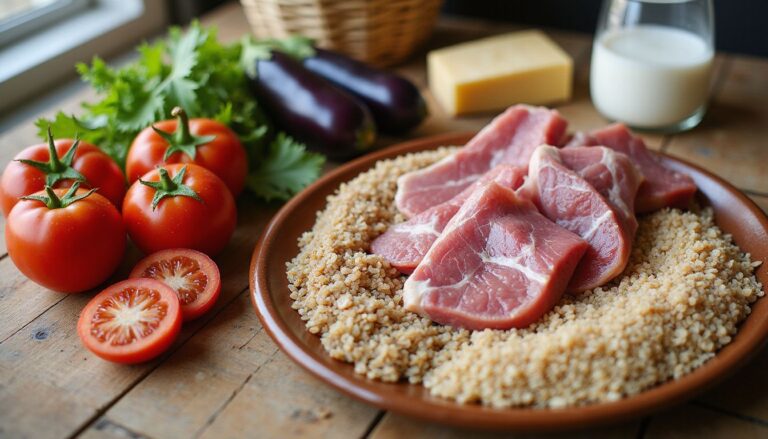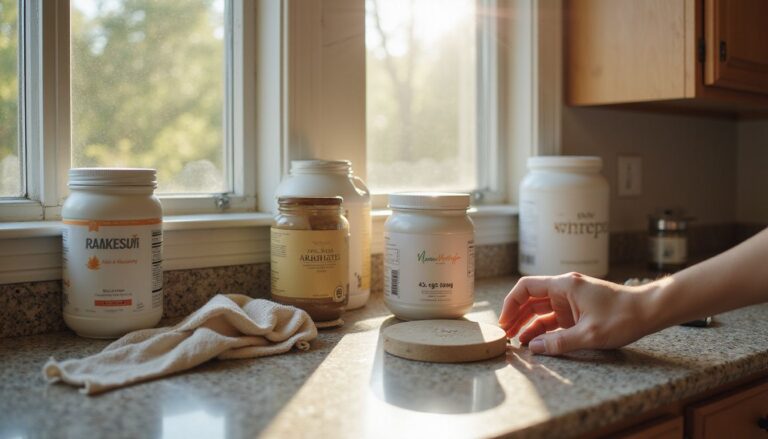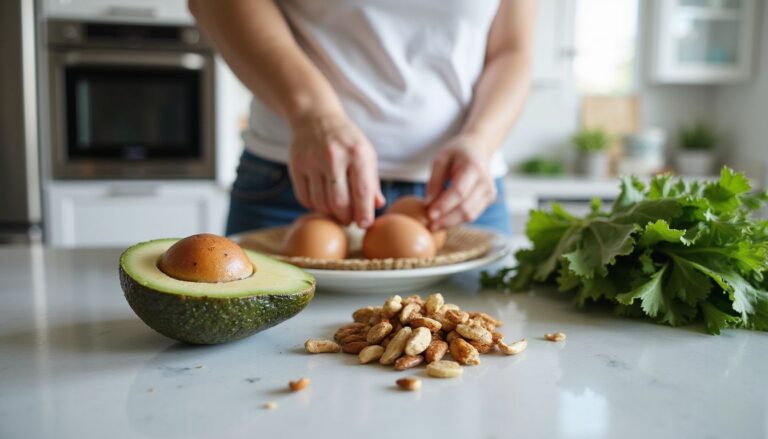Liquid Diet Weight Loss: Your Ultimate Guide To Shedding Pounds With Liquid Diets
Our Nutrition Assistant AI Suite will transform your body. You will lose fat, get toned, and build muscle. Gain confidence and optimal health.
Many people want to lose weight and keep it off, yet busy days make it tough. A liquid diet can cut calories fast, which may lead to quick results for some adults. This guide explains how these plans work, what to drink, and how to stay safe under medical advice.
You will see the main types of plans, from clear liquids to meal replacements, plus risks to watch for. Use the tips to judge if this approach fits your goals and health needs.
Keep reading to compare options and choose a plan that suits your routine.
Key Takeaways
- Liquid diets, including clear, full, and meal replacement types, can lead to rapid weight loss of 3–10 pounds in the first week when medically supervised.
- Reducing daily intake by 500–1,000 calories on liquid diets can achieve 1–2 pounds of weight loss per week, which matches CDC and NIDDK guidance.
- Risks include nutrient gaps, muscle loss, and electrolyte issues. Planning, high‑protein shakes, and medical oversight help reduce these risks.
- Up to 65% of adults regain most or all weight within six months after strict liquid plans, based on Journal of Obesity (2020) findings.
- Consult a clinician before starting, especially if you have diabetes, digestive disease, or are pregnant. Safety and balanced nutrition come first.

What Are Liquid Diets and Their Main Uses?

Liquid diets focus on drinks and foods that melt to liquid at room temperature. People use them for weight loss, surgery prep, or short-term medical care.
What Exactly Are Liquid Diets?
A liquid diet means you rely on drinks or foods that turn liquid at room temperature. Clear choices include water, broth, apple juice, tea, and coffee without cream. Full-liquid choices include milk, yogurt smoothies, pureed soups, and protein shakes.
Clinicians may prescribe a clear liquid diet before a colonoscopy or after surgery to rest the digestive system. Some people also try liquid diets for weight control with guidance from a registered dietitian.
Research suggests these plans can help in certain cases of obesity, diabetes, or digestive problems. They are low in fiber and often low in calories per day, so talk to your doctor before you start.
A liquid diet may be beneficial under medical supervision but should not replace balanced meals long-term.
What Are the Primary Reasons People Choose Liquid Diets?
People choose liquid diets to cut calories fast, manage symptoms, or prepare for procedures. A full liquid diet may be prescribed after bariatric surgery or before tests on the gastrointestinal tract.
Liquid meal replacements can also help control blood sugar by keeping portions predictable. Many find soups, broths, protein shakes, and fruit and vegetable smoothies easier to digest than solid food.
These plans can support short-term detox style cleanses, though long-term benefits are unclear. They can also help people who struggle to chew because of dental work or illness.
Types of Liquid Diets Explained
Several types of liquid plans exist. Each one serves a different purpose, from surgery prep to a structured weight loss program.
What Is a Clear Liquid Diet?
A clear liquid diet allows only see-through fluids without solid bits. Typical options are water, broth, apple or white grape juice, tea, and black coffee without cream. Plain gelatin without fruit is often allowed.
Doctors use this plan before tests or procedures on the gut, such as colonoscopies. It supplies hydration but very few nutrients. The main goal is to keep the stomach and intestine free of residue. It is also used during short recovery phases to ease nausea, vomiting, or diarrhea.
What Are the Benefits of a Full Liquid Diet?
A full liquid diet provides more calories and nutrients than clear liquids while still being easy to digest. You can include milkshakes, yogurt-based drinks, blended puddings, smoothies, and broths.
Clinicians may prescribe this diet before or after operations to reduce strain on digestion. Weight loss may happen because these diets are often low in calories. Hydration stays strong, and constipation may improve if you include high-fluid choices.
For people who cannot chew well, this plan offers a safer path to nutrition. Variety is possible with careful planning and supervision from a healthcare professional.
What Defines a Partial Liquid Diet?
A partial liquid diet mixes liquids with some soft or pureed foods. You might drink nutrient-rich shakes and broths, then eat yogurt, mashed potatoes, or cooked cereals.
Many plans replace one or two meals with a shake or soup to reduce calories. This approach can still provide dietary fiber and essential nutrients. Clinicians may recommend it during recovery phases or for digestive conditions to reduce discomfort.
With balanced choices, this plan can also support better blood sugar control and cholesterol levels.
What Are Meal Replacement Liquid Diets?
Meal replacement diets use formulated shakes or soups to stand in for one or two meals per day. These products supply protein, carbohydrates, vitamins, and minerals within a set calorie range, often 150–400 per serving.
They help with portion control and convenience. Some include added fiber for fullness. Trials show very-low-calorie plans that rely on replacements can produce significant short-term weight loss under medical care.
Why Are Medically Prescribed Liquid Diets Important?
Medically prescribed liquid diets serve precise medical goals. Doctors use them to prepare you for procedures or to manage digestive disease.
These plans are tailored to hydration and nutrition needs, including adequate protein and electrolytes like sodium and potassium. Medical monitoring helps prevent low blood sugar, muscle loss, and electrolyte problems. Supervised plans may include nutrient-dense broths, electrolyte drinks, and specific supplements.
How Liquid Diets Help with Weight Loss
Liquid diets reduce calories and simplify portions, which can lead to weight loss. Many clinical trials connect these plans to short-term results, especially with medical oversight.
How Does Reducing Calories Promote Weight Loss?
Weight drops when you burn more calories than you eat. A daily deficit forces your body to use stored fat for energy.
Experts often suggest cutting 500–1,000 calories per day to lose 1–2 pounds per week. This pace is considered safe for most adults by major health agencies. Liquid plans make calorie tracking simpler, since serving sizes are fixed and easy to measure.
How Does Portion Control Aid Weight Loss?
Portion control lowers calorie intake at each meal. Liquid meals, like protein shakes and blended soups, fill the stomach quickly, which can help you feel satisfied on fewer calories.
Shakes and broths are easy to measure, so you avoid unplanned extra servings. Smaller, steady portions support predictable progress and can reduce cravings over time.
What Role Does Detoxification Play in Losing Weight?
Some liquid diets promise detox benefits, which means they claim to help remove toxins. Evidence for lasting weight loss from detox approaches is limited. Most early changes come from water shifts and fewer calories, not fat loss.
Low-fiber liquid plans may lower LDL cholesterol for some people, but they can miss key micronutrients. A short cleanse might feel lighter, yet long-term success still depends on balanced nutrition and lifestyle habits.
What Are the Key Benefits of Following Liquid Diets?
Liquid diets can produce fast results, ease digestion, and save time. These benefits matter most during short periods with a clear medical plan.
How Can Liquid Diets Achieve Rapid Weight Loss?
Fast weight loss happens because many liquid diets provide only 800 to 1,200 calories per day. Your body then taps fat stores for energy. Low-carb and low-sodium choices can also cause early water loss, which drops scale numbers quickly.
Results vary based on your health, age, and activity level. Under medical care, some people lose 5 to 10 pounds in the first week.
| Diet Type | Average Daily Calories | Potential First-Week Loss |
|---|---|---|
| Clear Liquid Diet | 500–700 | 5–10 lbs |
| Full Liquid Diet | 1,000–1,200 | 3–7 lbs |
| Meal Replacement Shakes | 800–1,100 | Up to 8 lbs |
Reference: National Institute of Diabetes and Digestive and Kidney Diseases, Very Low-Calorie Diets, 2022.
How Do Liquid Diets Improve Digestive Health?
Liquids are easier to digest than solid food. They move through the stomach and intestines more quickly, which can reduce bloating and discomfort.
Clinicians often use clear liquids for digestive flare-ups or before procedures. A short full-liquid phase may calm symptoms of conditions like irritable bowel syndrome when supervised.
Why Are Liquid Diets Convenient and Time Efficient?
Shakes and blended soups cut prep time, shopping, and cleanup. Portion sizes are built in, so it is easier to stay on track during busy weeks.
Pre-made meal replacements can support consistent intake when time is tight. This structure helps you avoid skipped meals and last-minute takeout.
What Are the Potential Risks and Side Effects of Liquid Diets?
Liquid diets can create health risks if you are not careful. Learn how to protect yourself before and during any plan, especially if you have special medical needs.
How to Address Nutritional Deficiencies on a Liquid Diet?
Nutrient gaps can develop quickly. Choose products with at least 20 grams of protein per serving and look for vitamin D, vitamin B12, iron, calcium, zinc, and healthy fats.
Fortified beverages, powdered add‑ins, and blended vegetables can help. Tracking your intake with a simple app makes it easier to spot patterns and fix them early. People who are pregnant or nursing should discuss added vitamin needs with a clinician first.
How to Prevent Muscle Loss During a Liquid Diet?
Use high-protein drinks like whey, casein, soy, or pea protein. Aim for 0.8 to 1 gram of protein per kilogram of body weight each day. Split protein across several servings to keep a steady supply of amino acids for muscles.
Light strength training, if approved by your doctor, can help your body hold on to lean mass. Stop and seek advice if you feel unusual weakness or fatigue.
How to Manage Electrolyte Imbalances?
Electrolytes like sodium, potassium, and magnesium are vital for nerves and muscles. Replace them with oral rehydration solutions, low-sugar sports drinks, or fortified shakes. Avoid overhydration, which can also upset balance.
Watch for cramps, fatigue, dizziness, or confusion. Contact a clinician right away if symptoms appear, especially if you notice an irregular heartbeat.
What Is the Risk of Regaining Weight After a Liquid Diet?
Regain is common after strict liquid plans. A sudden drop in calories can slow your metabolism. Once you return to regular meals, weight can climb back up.
Many people gain back most of what they lost within six months. A gradual transition to balanced solid meals and steady activity helps protect your progress.
How to Start a Liquid Diet Safely
Starting well reduces risk and raises your chance of success. A short planning session can save you from costly mistakes later.
Why Consult Healthcare Professionals Before Starting?
Speak with a clinician before you begin. They can review your health, medications, and lab results to see if a liquid plan is safe for you.
Supervised programs reduce complications like severe nutrient gaps or electrolyte problems. A clinician can also set calorie targets and advise on complete nutrition during your plan.
How to Set Realistic Weight Loss Goals?
Set a steady pace, such as 1 to 2 pounds per week. Track calories and weight using a simple app or a notebook.
Break large goals into smaller milestones. Celebrate progress with non-food rewards to keep motivation high.
How to Choose Nutritionally Balanced Liquids?
Pick liquids with solid protein, healthy fats, and key vitamins and minerals. Try to get at least 20 grams of protein per serving to help protect muscle.
Limit added sugars. The American Heart Association suggests keeping added sugar under 25 grams per day for women and 36 grams per day for men. Fortified milk, soy drinks, and protein shakes help fill common nutrient gaps.
What Foods and Drinks Are Recommended on Liquid Diets?
Aim for nutrient-dense choices. Build your plan around hydration, protein, and steady energy.
What Are Ideal Fruits and Vegetable Juices?
Fresh juices from apples, oranges, and berries supply vitamins and antioxidants. Vegetables like carrots, spinach, beets, and cucumbers create a strong base.
Use a juicer or blender and avoid store-bought juices with added sugar. Simple mixes like apple-carrot, spinach-cucumber, or orange-beet taste good and support nutrition.
What Protein Shakes Are Suggested?
Protein shakes help preserve muscle during calorie deficits. Choose whey isolate, casein, soy, or plant blends such as pea and brown rice. Look for 15–25 grams of protein and low added sugar per serving.
Dairy-free options can use soy or pea protein with unsweetened almond milk. Rotate flavors to prevent taste fatigue.
What Types of Broths and Soups Are Best?
Clear chicken, beef, or vegetable broths are easy to digest and low in calories. Choose low-sodium versions to help control blood pressure and fluid balance.
Blended soups made from carrots, tomatoes, squash, or lentils add vitamins and some protein. Strain well for a smooth texture. Skip rich cream-heavy recipes unless a clinician approves them.
Which Yogurt-Based Smoothies Are Recommended?
Use low-fat Greek yogurt to increase protein and calcium. Add fruits like strawberries, blueberries, or bananas for flavor and antioxidants.
For fiber, blend in spinach or chia seeds. Unsweetened almond milk or skim milk keeps calories in check. Keep yogurt plain to avoid extra sugars, then sweeten lightly with a small amount of honey or stevia if needed.
How to Choose Between Dairy and Plant-Based Milks?
Compare labels for protein, calcium, added sugar, and vitamins. Dairy milk has about 8 grams of protein per cup. Many almond or oat drinks have less unless fortified, while soy milk is closer to dairy in protein.
Choose based on tolerance and goals. If you avoid lactose or eat vegan, plant-based options can work well, especially fortified versions.
Five-Day Sample Plan for a Liquid Diet
This five-day outline provides structure and a safe ramp back to solids.
What to Eat on Day 1: Clear Liquids and Light Broths?
Start with hydration and gentle options: water, herbal tea without milk, clear apple juice, and diluted sports drinks.
Use light broths such as chicken, beef, or vegetable to supply electrolytes and help with hunger. Sip small amounts every hour to avoid dehydration. Plain gelatin and pulp-free flavored water are usually allowed.
What to Eat on Day 2: Adding Smoothies and Protein Shakes?
Introduce smoothies and protein shakes. Blend low-fat yogurt, frozen berries, and a banana with unsweetened almond milk or skim milk. Add spinach or kale for extra nutrients with mild taste.
Choose protein shakes with at least 15 grams of protein and under 8 grams of sugar per serving. Mix protein powder with water or plant milk if you want to avoid lactose.
| Time | Option |
|---|---|
| 8 am | Spinach-banana smoothie with Greek yogurt and almond milk |
| Noon | Whey protein shake |
| 3 pm | Berry smoothie with skim milk and chia seeds |
| 6 pm | Plant-based protein shake |
What to Eat on Day 3: Incorporating Thicker Soups and Blended Meals?
Add pureed soups like butternut squash, carrot, or lentil. Blend until smooth and strain if needed. Replace some juices with yogurt-based smoothies for more protein and fullness.
Aim for 20–25 grams of protein per serving at one to two meals. Choose low-sodium broths and low-sugar mixes to support steady weight loss.
What to Eat on Day 4: Maintaining Balanced Liquid Nutrition?
Focus on balance. Include protein smoothies with leafy greens and berries, plus fortified dairy or soy milk for calcium and vitamin D.
Use clear broths, vegetable juices, and complete meal replacement shakes that provide 200–300 calories per serving. Rotate choices to cover protein, fiber, vitamins, and minerals without boredom.
How to Transition Gradually to Solid Foods on Day 5?
Introduce soft, easy-to-digest solids like scrambled eggs, cooked oatmeal, ripe bananas, or soft-cooked carrots. Start with small portions and chew well.
Keep high-protein shakes or broths between meals as you adjust. If you tolerate breakfast and lunch, increase dinner slightly. Slow steps help prevent stomach upset.
Important Considerations Before Starting a Liquid Diet
Health status and medications can affect safety. A short check with your clinician can prevent problems later.
What Should Pregnant or Nursing Women Know?
Most weight-focused liquid diets are unsafe during pregnancy or breastfeeding. These stages require extra calories and nutrients for you and your baby. Low-calorie plans can cause nutrient shortages and low energy.
Some shakes include sweeteners or herbs that are not recommended. Always work with your healthcare provider for safe nutrition guidance.
Why Is Medical Supervision Necessary for Long-Term Use?
Long-term liquid diets increase the risk of low electrolytes, heart rhythm problems, and nutrient shortages. Regular checkups and lab tests help catch issues early.
Clinical monitoring also helps you adjust protein, calories, and supplements to protect muscle and energy levels.
What Are the Dangers of Extreme Caloric Restrictions?
Very low intakes, especially under 800 calories per day, raise the risk of gallstones, electrolyte imbalances, and muscle loss. You may feel dizzy, lightheaded, or overly tired.
Severe restriction can slow your metabolism. Many people then regain weight once they return to regular eating. Balance and supervision reduce these risks.
Who Are Ideal Candidates for Liquid Diets?
Some people benefit more than others. Fit the plan to your health needs and timeline.
How Do Liquid Diets Prepare Individuals for Surgery?
Before operations, doctors often use clear or full liquids to empty the stomach and lower complications. Faster digestion and a cleaner digestive tract improve safety during the procedure.
Follow your clinician’s exact instructions. Hydration and adequate protein are key priorities before surgery.
How Do They Support People with Digestive Conditions?
Liquid diets can reduce digestive workload for gastritis, Crohn’s disease, ulcerative colitis, or after surgery. Lower fiber and smoother textures can ease pain, nausea, and bloating.
Short-term use gives tissues time to heal. Broths, shakes, and electrolyte drinks provide some nutrition while digestion recovers.
Who Benefits from Liquid Diets for Short-Term Weight Loss?
Adults without complex medical issues who need quick results for medical procedures or a reset may benefit. Short-term meal replacement plans can reduce body fat under supervision, especially before bariatric surgery.
These plans also help people who struggle with portions. Structure and simple choices limit excess calories and support fast changes.
How Do Liquid Diets Compare to Regular Diets?
Liquid plans work differently from typical eating patterns. Comparing them helps you plan for both results and safety.
How Do Calorie Intakes Differ?
Most adults need 1,800 to 2,400 calories daily to maintain weight. Liquid diets often provide only 800 to 1,200 calories per day.
This gap explains the rapid early loss for many people. Replacing all meals with shakes or soups can cut your energy intake by half for a short time.
How Sustainable Are Liquid Diets Long-Term?
Sticking with only liquids for months is tough. People often miss the act of chewing and social meals. Many switch back to solids after several weeks because of cravings and events.
Long-term weight control works better with balanced meals, protein, fiber, and habits you can keep for life.
How Do They Compare in Nutritional Adequacy?
Liquid plans can fall short on fiber, healthy fats, and some vitamins and minerals unless you plan carefully. Whole foods usually provide a wider range of nutrients and about 25–30 grams of fiber per day. Many liquid plans provide far less.
Protein can also drop unless you choose high-protein shakes and dairy or soy options. Aim for 46–56 grams of protein daily at minimum, adjusted to your body size and activity.
What Are Tips for Success on Liquid Diets?
A few simple habits can make this plan safer and more effective.
Why Is Staying Hydrated Important?
Every cell needs water to function. Poor hydration can cause headaches, dizziness, cramps, or constipation.
During a liquid plan, drink fluids consistently. Include electrolyte drinks if recommended. A glass of water before each shake may help curb hunger and keep energy stable.
How to Include High-Protein Liquids?
Use whey, soy, or pea protein powders in shakes. Fortified dairy or soy milk gives 7–10 grams of protein per cup. Greek yogurt smoothies add protein and calcium.
Consider silken tofu or pureed cottage cheese to raise protein in soups without changing texture. Target 10–20 grams of protein per meal or snack.
How to Monitor Your Progress Effectively?
Weigh yourself daily with a digital scale, then log results to see trends. Measure your waist weekly and note how clothes fit. Take simple progress photos under similar lighting.
Track energy levels and sleep. Summarize results weekly, then adjust calories or activity if progress stalls.
Frequently Asked Questions About Liquid Diets
These quick answers cover common concerns, from timing to exercise.
How Long Can You Stay on a Liquid Diet?
Most plans last three to fourteen days. Medical protocols before procedures may last one to three days. Some supervised weight loss programs allow up to two weeks.
Longer use raises the risk of nutrient and electrolyte issues. Work with a clinician if your plan lasts beyond two weeks.
Can You Exercise While on a Liquid Diet?
Light movement, like walking or gentle yoga, is usually fine. Intense training is not recommended because recovery needs more fuel and nutrients.
Stop if you feel dizzy or weak. Ask your clinician for personal advice based on your health status.
How Effective Are Liquid Diets for Long-Term Weight Loss?
These plans often deliver quick results because calories drop sharply. Long-term maintenance is harder without lasting changes in eating habits.
Many people regain some or all of the weight within a year. For best outcomes, pair any short-term liquid phase with a plan to transition to balanced meals and steady activity.
Conclusion
Choosing a liquid diet for weight loss can provide structure, clear portions, and faster early progress. You now know the main types, how they lead to weight change, and where risks can appear.
Work with a healthcare professional to set safe calorie targets, protect muscle with protein, and track electrolytes. Plan your transition back to balanced solid meals for lasting results. With preparation and medical guidance, a liquid diet may support your goals while protecting long-term health.
Medical disclaimer: This guide is educational and does not replace personal medical advice. Always consult your clinician before starting or changing a diet.
FAQs
1. What is a liquid diet for weight loss?
A liquid diet for weight loss replaces most or all meals with liquids such as shakes, smoothies, broths, and juices. These plans often provide fewer calories than solid food diets and may help some people lose body fat quickly. Clinical studies show that supervised low-calorie liquid diets can lead to significant short-term weight reduction.
2. Are liquid diets safe for long-term use?
Most health experts recommend using liquid meal plans only under medical supervision and not for extended periods. Research shows that very low-calorie fluid-based regimens can cause nutrient deficiencies if followed too long without guidance from a healthcare provider.
3. How much weight can someone expect to lose on a fluid meal plan?
Weight loss varies based on calorie intake, starting body mass, activity level, and adherence to the program. According to data published in peer-reviewed journals, participants following medically supervised low-calorie drink-based programs lost between 15 and 25 pounds over three months.
4. Can you share an example of success with this approach?
One participant shared her experience after completing a physician-monitored shake regimen lasting eight weeks; she reported losing 20 pounds while learning portion control skills that helped maintain results after returning to regular foods.
Summary: Liquid meal plans offer rapid initial fat loss but require careful planning and professional oversight due to possible nutritional gaps. Evidence supports their effectiveness when used safely under expert care for limited durations.







